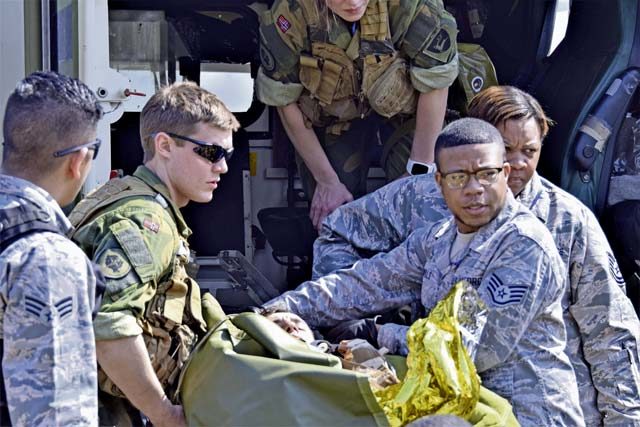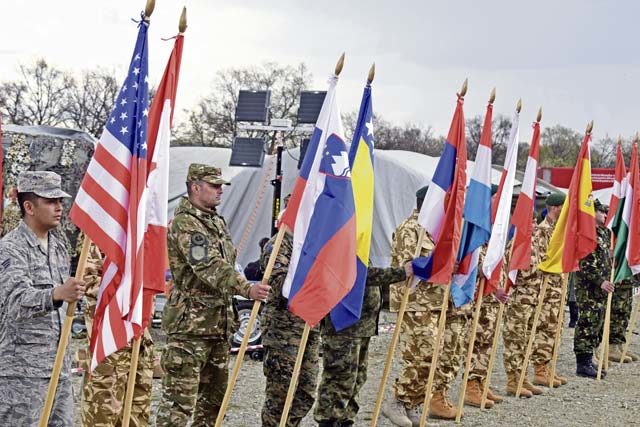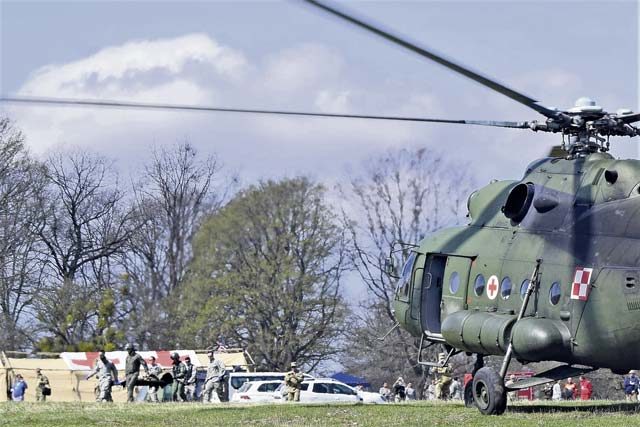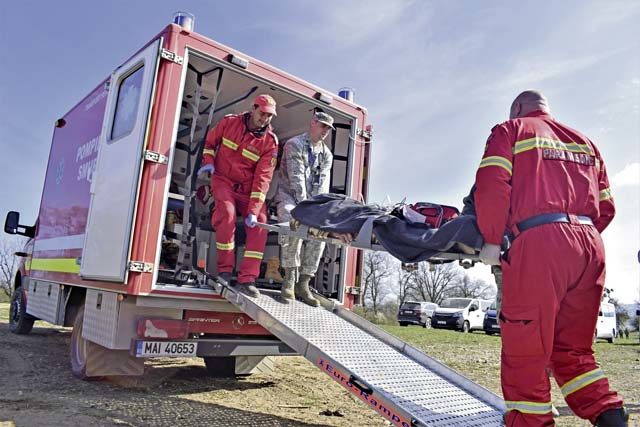
CINCU, Romania — Exercise Vigorous Warrior 19, NATO’s largest-ever medical readiness event, ended Friday with ceremonies at Cincu Military Base, Romania. Beginning April 3, approximately 50 Airmen from the 86th Medical Group worked with over 2,500 military personnel from 39 NATO and partner countries to improve interoperability and readiness in a simulated Article 5 combat scenario.
For the U.S. Airmen participating, the exercise provided valuable experience operating an expeditionary medical support system (EMEDS), essentially a modular field hospital designed to be deployed and fully operational within six hours of arrival in an area of responsibility. The EMEDS is considered a Role 2 medical facility under NATO doctrine.
“When we started the exercise, I asked the team how many of them had deployed in a setting of trauma patients and only seven people raised their hands out of the 49 we have here,” said Chief Master Sgt. Amy Riley, 86 MDG, group superintendent. “I think one of the lessons learned for them is the ability to move outside a clinical setting, which is very controlled, into a very uncontrolled environment. It proves a lot when you put them in a realistic training scenario such as this, pushing them outside their comfort zone.”
This year marks the fifth time Vigorous Warrior has been held biannually at locations across Europe, and the first time that U.S. Air Force assets have participated in the exercise.
During Vigorous Warrior 19, medical personnel were subjected to a rigorous operations tempo that included more than 1,000 scenario injects, 300 medical actions, and more than 1,500 simulated casualties. The two-year planning process for this battery of drills was overseen by the NATO Centre of Excellence for Military Medicine, Budapest, Hungary, led by Col. Dr. László Fazekas, Hungarian Armed Forces.
“From these 39 nations, it’s not only military personnel, but civilian medical specialists,” said Fazekas. “In every Vigorous Warrior exercise, we try to include a new theme into the training objectives, and this time one of the new things was to work on close cooperation with civilian medical forces; in this exercise we had 600 civilians participating from many non-governmental organizations, as well as the disaster response systems of Romania and Hungary.”
Fazekas also pointed out that cooperation between military and civilian medical counterparts works for the benefit of troops and civilians alike, helping to ensure the best possible stewardship of resources by sharing and pooling knowledge, experience, equipment, and facilities.
“It is a military medical platform for many issues, first of all training for multinational personnel; but as a platform, it has many other purposes,” said Fazekas. “We can test our new concepts here, we can test doctrine, and we can even perform scientific research together.”

Airmen participating in Vigorous Warrior 19 took full advantage of the opportunity to share knowledge and build professional relationships with colleagues from a diversity of backgrounds. On Thursday, a surgical team from the 86 MDG integrated into the exercise’s Romanian armed forces Role 3 medical facility, and vice versa. Both teams participated in a pair of challenging surgical drills at their respective sites, adapting together in an unfamiliar space with colleagues who did not share a native language. Experts from the NATO MilMed COE said afterward that had the exchange occurred in a real-world scenario, the surgical actions performed would likely have been successful in saving the patients’ lives.
“With our Romanian partners coming into our facility, we demonstrated that we can actually stabilize patients in an integrated environment,” said Col. Michael Roberts, 86 MDG, commander. “The interoperability piece to that is huge, because it’s not going to be individual nations operating alone in an Article 5 combat situation; it would be all of us in NATO, participating across a common line as partners.”
The 86 MDG’s participation in Vigorous Warrior 19 was funded by the European Deterrence Initiative, which underwrites improvements and activities that increase U.S. European Command’s warfighting capabilities, assuring our allies of the U.S. commitment to regional security and territorial integrity while simultaneously increasing the capability, readiness, and responsiveness of the alliance’s forces.
The dividends from this kind of investment into U.S./European strategic partnerships are clearly visible.
“The strategic importance of multinational training, especially in a NATO context, is absolutely monumental; it’s paramount to us doing our job from an Article 5 perspective,” Roberts said. “The more we can do this, collectively, as a group of nations on the field, the better off we’ll be if we are called upon to do this in the real world.”




